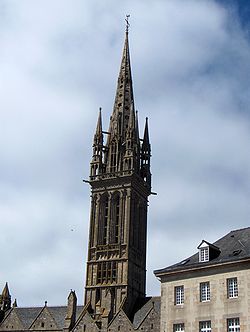- Kreisker chapel
-
Notre Dame du Kreisker 
The Kreisker is a famous church of Brittany
Basic information Location Saint-Pol-de-Léon, Brittany, France Geographic coordinates 48°41′08″N 03°59′19″W / 48.68556°N 3.98861°W Affiliation Roman Catholic Ecclesiastical or organizational status Pilgrimage Chapel Architectural description Architect(s) Unknown (English) Architectural type Chapel Architectural style Romanesque art Direction of façade Monument historique Completed 15th Specifications Height (max) 78m Materials Granite The Notre-Dame du Kreisker chapel (French: Chapelle Notre-Dame du Kreisker, Breton: Chapel Ar C’hreizkêr) is a former Roman Catholic chapel in Saint-Pol-de-Léon in Brittany. With its 78 meters rising up in the sky, the church tower of the "Chapelle du Kreisker" is the highest in Brittany. The word Kreisker means the downtown. Built in 14th and 15th centuries on the site of an ancient place of worship, it’s one of the major works of Breton religious architecture and a testimony of the flourishing economy of the town in 15th century with the highest (78 m) and most audacious belfry in Brittany. An essential coastal landmark for navigation, it was for that reason restored and thus saved from destruction on Napoleon’s order in 1807. Striking circular view from the top (169 steps).
History
The origin of the chapel goes back to the 6th century. A young linen maid who had worked on a holiday in the honour of the Virgin, despite Saint Kirec disapproval became suddenly completely paralysed. After her repentance the Saint healed her and she gave him her house to be converted into a chapel. The chapel was called "Kreis-Ker" because it was located in the middle of a village, in the inner suburb of St Pol de Léon. It is likely that the first chapel was made of wood and it must not have withstood the ravages of the Normans in the 9th century.
The tradition related that the English after having burnt the town in 1375, have rebuilt the Kreisker. Some architectural features such as the "perpendicular style" at the base of the tower are the obvious sign of an influence from across the Channel. Settled on a long-term basis in St Pol de Léon after the war of succession of Brittany, the English could, indeed, convert the tower into a look-out post turned towards the sea and the surrounding countryside. A guard room in the north porch is a virtually intact example of a conventional accommodation at the end of the 14th century.
In the 15th century, after the departure of the English, the tower was crowned by a superb spire and the edifice was slightly modified. The steeple has been saved from demolition by Napoléon in 1807 thanks to its usefulness for navigation. Throughout the middle ages util the Revolution, the city council used the Kreisker as assembly room.
Still today, the chapel and its tower applies a powerful presence on the city. Norman and British influences are visible on the architecture of this classified historic monument.
Description
The tower rests on 4 pillars each side of a height of 3.20 m. When comparing the light-weight of the pillars to the height of the tower they support, one can hardly understand that this massive structure stands on apparently such a weak foundation. Magnificent specimen of "clocher à jour" the granit spire is an octagon pierced by 80 openings which do not let the wind buffet it. The north porch (flamboyant style) is more work than the south porch (contrary to the tradition of the period).
From the balustrade that can be accessed by a staircase of 169 steps, one can enjoy a splendid and awesome panorama. The church tower can be accessed in July and August to allow the viewer to enjoy the view on all the region from its top railing.
Bibliography
- Philippe Abjean, Notre-Dame du Kreisker, Léon'Art éditions, 2011, 171 p.
Categories:- Chapels in France
- Buildings and structures in Finistère
- 14th-century architecture
- French church stubs
Wikimedia Foundation. 2010.
